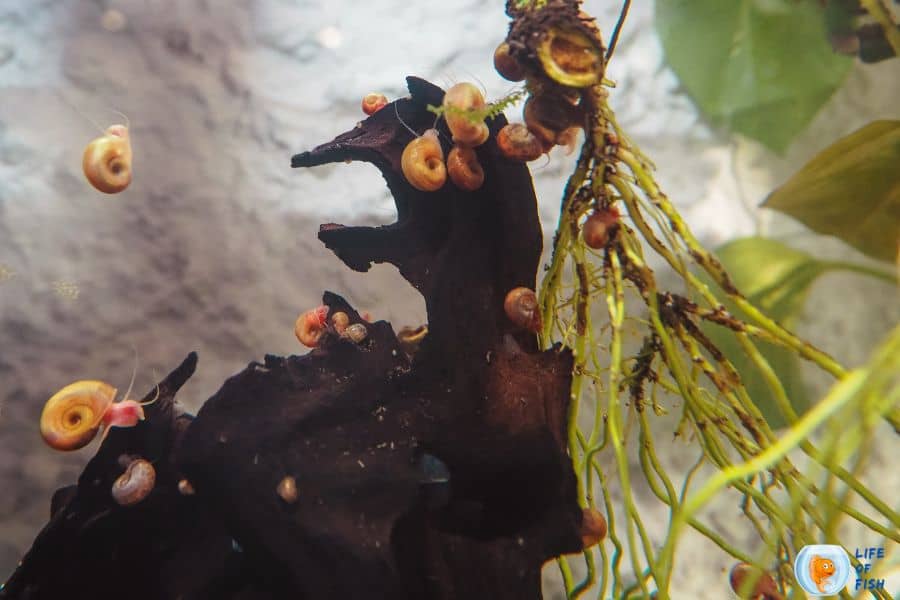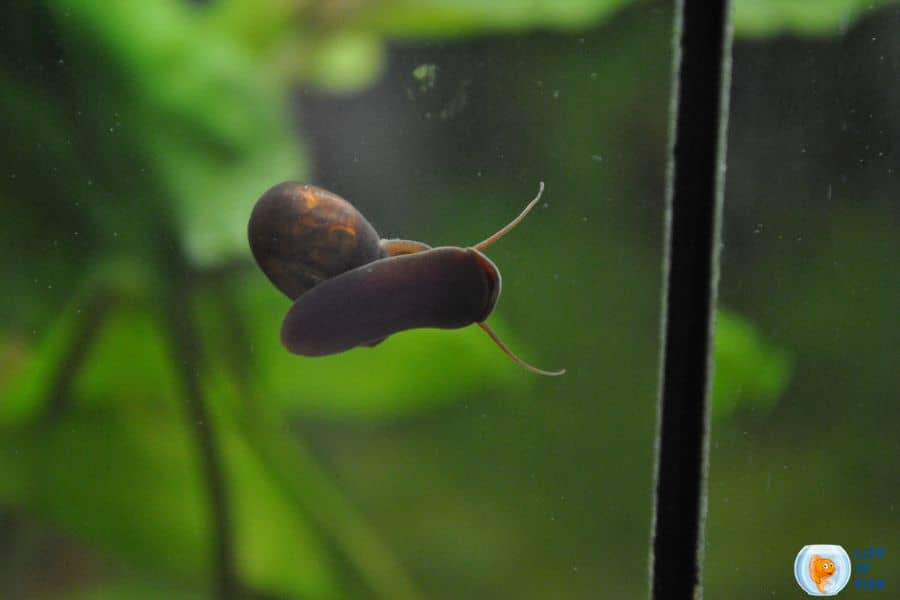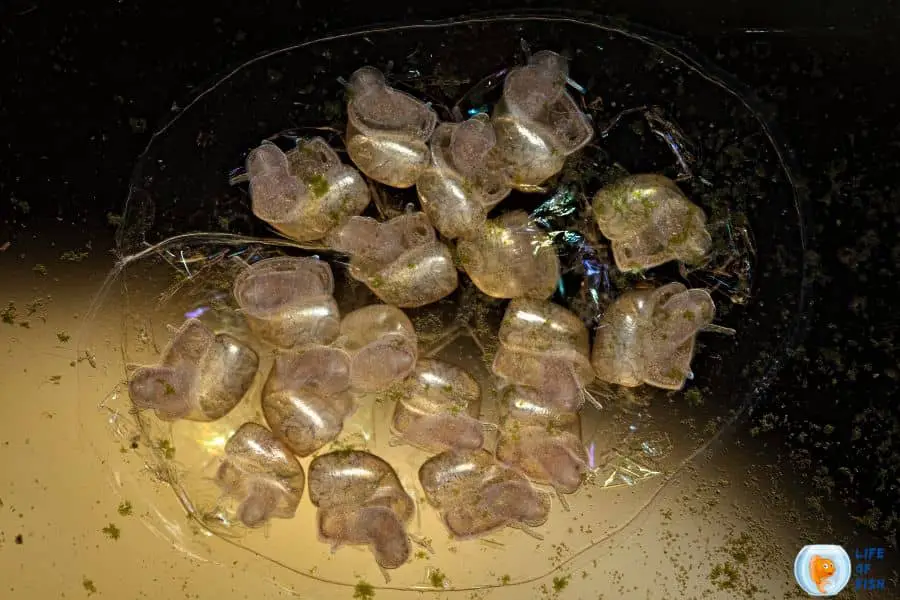Once I had a perfect fish tank with mystery snails, corydoras, and guppies. I kept perfect water conditions and fed them on a daily basis. One day, Baby Snails Appeared In My Fish Tank, and at first, I wasn’t sure what to do.
However, after a while of watching them, I found they were harmless and actually pretty entertaining to watch. Over time, they began to multiply and spread throughout the entire tank.

After a few days, hundreds of baby snails appeared in my fish tank, and controlling them was a big challenge.
I tried various means to get rid of them, but none of them worked. Then I began to find out more about pest snails online to find a solution. And at last, I eventually got rid of them.
If you’re in a similar state, here are some suggestions for dealing with baby snails in your aquarium:
Baby Snails Appeared In My Fish Tank; What are they?
Jump To
- 1 Baby Snails Appeared In My Fish Tank; What are they?
- 2 How did Baby Snails Appeared In My Fish Tank?
- 3 Should I remove snails from my aquarium?
- 4 How to get rid of aquarium snails naturally
- 5 Using chemical treatments to get rid of baby snails
- 6 How do I control snails growing in my aquarium?
- 7 Aquarium fish that eat snails
- 8 Conclusion
Before trying to get rid of these snails, the first thing you need to do is identify the type of snail.
There are many different types of snails, and not all of them are pests. Some snails are actually beneficial to your tank, and they can help keep the water clean and clear.
To determine whether or not your snails are pests, try observing them closely. If they seem to be eating your plants or fish or multiplying too quickly and overtaking your tank, they are likely pests and should be removed. The following is a list of some common pest snails:
Types of pest snails
- Bladder / Pond Snails (Physella acuta)
Bladder snails are one of the most common types of pest snails. They are usually gray in color and have a teardrop-shaped shell. They can grow about half inches in size and are known to reproduce quickly.
Bladder snails are often introduced to fish tanks through live plants. They are also known to hitchhike on other aquarium items such as driftwood, decorations, and fish food.
- Tadpole / Pond Snails (Lymnaea stagnalis)
Tadpole snails are another common type of pest snail. They are larger than bladder snails and can grow up to 6 cm in size. They have a brown or black shell that is shaped like a tadpole.
Tadpole snails are often introduced to fish tanks through live plants. They’ve also been seen riding on other aquarium fixtures, such as driftwood, decorations, and fish food.
- Malaysian Trumpet Snails (Melanoides tuberculata)
The Malaysian trumpet snail is another common type of pest snail. These snails are orange, red, black or brown in color, have a trumpet-shaped shell, and can grow up to 3 cm in size.
The Malaysian trumpet snail is often seen on the aquarium glass, and they are known to eat leftover fish food and algae. They can also reproduce quickly, soon becoming a major pest if you have a few of them in your tank.
- Ramshorn Snails (Planorbarius corneus)
Ramshorn snails are common snails that can be red, brown, blue, or black in color. They have a coiled, horn-shaped shell, and they can grow up to almost one inch in size.
Ramshorn snails are typically more active than other types of pest snails, and they are known to eat algae, decaying plant matter, and leftover fish food. They can also reproduce very quickly in your tank, so it’s essential to remove them if you detect any in your tank.
How did Baby Snails Appeared In My Fish Tank?
Snails can get into your fish tank in a variety of ways. If you grow live aquatic plants in your aquarium, they may be breeding snails on them, which can then get into your tank.
Alternatively, if you have any decorations or aquarium fixtures that contain snails (such as driftwood or fish food), they may bring snails into your tank.
To prevent baby snails from getting into your tank, you should inspect all live plants and aquarium fixtures before adding them to your tank.
If you see any snails on them, simply remove them and dispose of them. To be safe, you should quarantine any new plants or aquarium fixtures for a few weeks before introducing them to your main tank.
Some aquarists prefer to dip the plants and decorations in bleach to kill any snails before adding them to the tank; however, this is not always necessary and successful.
Some pest snails can survive after a bleach bath and will quickly repopulate your tank. If you choose to dip your plants and decorations in bleach, rinse them thoroughly before adding them to your aquarium.

Should I remove snails from my aquarium?
If you have a few pest snails in your aquarium, removing them is generally not necessary. However, if they are multiplying quickly and becoming a nuisance, you may want to consider removing them.
How to get rid of aquarium snails naturally
If you’re dealing with a snail infestation in your aquarium, there are several steps you can take to get rid of them naturally.
Avoid overfeeding your fish
One of the main reasons snail populations explode in aquariums is overfeeding. Snails are opportunistic feeders and will often eat leftover fish food that sinks to the bottom of the tank.
To avoid overfeeding your fish, only feed them as much as they can eat in one to three minutes, and try to clean up any leftover food after they’re finished eating.
Add natural predators
Some types of fish can act as natural predators for snails. For example, loaches, plecostomus, and otocinclus catfish can all help to keep snail populations under control.
If you have a fresh water tank, you can also add Assassin Snails (Clea Helena) to your tank. Assassin snails are voracious predators of other snails and can help to keep their population under control.
Remove them manually
You can manually remove snails from your aquarium by using a siphon to vacuum them out of the tank. If you have quite a few snails, you may have to do this process a few times before getting rid of them all. Alternatively, you can also use a net to scoop out the snails.
Remove any egg clusters that you see, as these will quickly hatch and repopulate your tank with more snails.
Do regular water changes
In addition to removing pests manually, you should also make sure that you’re doing regular water changes to keep the water in your tank clean.
Frequent water changes will help remove any decaying food or plant matter that the snails are feeding on, which will help reduce their population.
Using chemical treatments to get rid of baby snails
If you have a severe snail infestation, you may consider using a chemical treatment.
A few different types of commercial snail treatments are available for aquariums, such as copper sulfate and metaldehyde.
However, chemical treatments should always be used with caution, as they can negatively affect your fish, invertebrates, and other plants in your tank.
In general, it’s usually best to avoid using chemical treatments unless your snail infestation is severe and you have exhausted all other options.
How do I control snails growing in my aquarium?
Pest snails need food, shelter, and water to survive in your aquarium, so preventing them from gaining access to these essentials is important. To prevent snails from reproducing in your aquarium, make sure to:
- Clean up any leftover food: Snails are opportunistic feeders who will devour fish food that has settled at the bottom of the aquarium. So, when you clean up your aquarium, be sure to remove any uneaten fish food.
- Remove hiding places: Many snail species like to hide in dark, tight spaces, so removing any extra decorations or plants from your tank can help discourage snails from taking up residence in your aquarium.
- Remove any decaying plants or debris from the tank: Snails are attracted to decaying plants and debris, so removing these from your tank can help to discourage them from taking up residence.
- Regularly vacuum the gravel to remove any eggs or snail larvae: Snail eggs are tiny and tough, so you may need to vacuum the gravel in your tank to remove them regularly.
- Do regular water changes to remove excess nutrients from the water: Excess nutrients in the water can encourage algae growth, providing food for snails. So, doing frequent water changes can help to remove excess nutrients and keep your tank clean.
Additionally, you can also add a few natural predators to your aquarium. Below are some aquarium fish (and snails!) that can help control pest snails in your tank.

Aquarium fish that eat snails
Assassin Snails (Clea Helena)
Assassin snails are voracious snail predators and have been known to eat up to 200 snails per day. They are also excellent at controlling populations of bladder snails.
Clown and Yoyo loach (Botia spp.)
Clown loaches are among the best snail-eating fish available for the home aquarium. A group of clown loaches can quickly reduce the snail population in your tank.
Plecostomus (Hypostomus plecostomus)
The plecostomus, or Pleco, is a well-known snail-eating fish. These bottom-dwelling fish are excellent at controlling populations of pond snails, Malaysian trumpet snails, and other common snails in an aquarium.
Betta fish (Betta splendens)
Betta fish are beautiful and popular freshwater fish, but they also have a taste for snails. If you have a betta fish in your aquarium, it may help to control the snail population.
Goldfish (Carassius auratus)
Goldfish are another popular aquarium fish that will gladly eat snails. These voracious eaters can help to keep the snail population under control.
Corydoras catfish (Corydoras spp.)
Corydoras catfish are small bottom-dwelling fish that love to eat leftover food. While they do not eat snails, they will eat snail eggs within their reach.
While these fish can aid in snail management in your aquarium, they should not be relied on as a sole source of snail control.
Further, most predator fish eat snails if the shell is broken or removed. Although it may seem inhumane, the best way for your fish to control the snail population is to feed your fish crushed snails.
You can do this with your hand or a tool. Once the shell is crushed, your fish will happily eat the snail inside.
Conclusion
As you can see, regulating the snail population in your aquarium can be accomplished through various methods.
Cleaning up any leftover food or rotting matter, vacuuming the gravel to eliminate eggs and larvae, and adding natural predators like clown loaches, assassin snails, and plecostomus are some of the more efficient approaches.
However, it is important to remember that you should use these methods with caution and never rely on predator fish as your sole method of snail control.
Ultimately, the best way to keep a healthy balance of snails and other aquatic life in your tank is to maintain a regular cleaning schedule and keep the water quality high. Good luck!
Read Next : How To Use A Siphon Pump For A Fish Tank?
